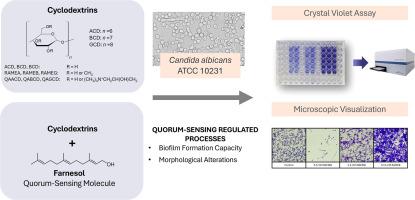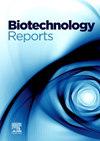环糊精的作用:调节白色念珠菌生物膜的形成和形态
Q1 Immunology and Microbiology
引用次数: 0
摘要
本研究的主要目的是探讨环糊精在减少白色念珠菌生物膜形成中的生物活性潜力。在0.1至12.5 mM的浓度范围内,研究了天然环糊精和特定衍生物的浓度依赖性效应,以确定生物膜形成程度降低的机制。此外,还考察了环糊精和法尼醇的不同组合作为抗真菌物质的效果。本研究揭示了环糊精对生物膜形成的刺激和抑制作用,这取决于其结构和浓度。随机甲基化的α-和γ-CD的生物活性潜力显示出显著的抗真菌特性,这可以通过减少生物膜形成来证明。此外,随机甲基化的环糊精可以显著增强法尼醇对白色念珠菌的抗真菌活性。因此,它们的协同作用可能为生产低剂量但更有效的抗药制剂提供了极好的机会。本文章由计算机程序翻译,如有差异,请以英文原文为准。

Cyclodextrins in action: Modulating candida albicans biofilm formation and morphology
The primary objective of this research was to explore the bioactive potential of cyclodextrins in attenuating biofilm formation in C. albicans. The concentration-dependent effects of both native cyclodextrins and specific derivatives were studied at concentrations ranging from 0.1 to 12.5 mM, to determine the mechanisms by which the extent of biofilm formation can be reduced. Besides, the efficiency of various combinations of cyclodextrins and farnesol, as an antifungal substance, were examined.
The present study revealed both stimulatory and inhibitory effects of cyclodextrins on biofilm formation, depending on the structure and concentration. The bioactive potential of randomly methylated α- and γ-CD showed significant antifungal properties, as evidenced by a reduction in the biofilm formation. In addition, randomly methylated cyclodextrins were found to significantly enhance the antifungal activity of farnesol against C. albicans. Consequently, their synergistic effect may provide an excellent opportunity to produce a lower dose but more effective anticandidal formulation.
求助全文
通过发布文献求助,成功后即可免费获取论文全文。
去求助
来源期刊

Biotechnology Reports
Immunology and Microbiology-Applied Microbiology and Biotechnology
CiteScore
15.80
自引率
0.00%
发文量
79
审稿时长
55 days
期刊介绍:
Biotechnology Reports covers all aspects of Biotechnology particularly those reports that are useful and informative and that will be of value to other researchers in related fields. Biotechnology Reports loves ground breaking science, but will also accept good science that can be of use to the biotechnology community. The journal maintains a high quality peer review where submissions are considered on the basis of scientific validity and technical quality. Acceptable paper types are research articles (short or full communications), methods, mini-reviews, and commentaries in the following areas: Healthcare and pharmaceutical biotechnology Agricultural and food biotechnology Environmental biotechnology Molecular biology, cell and tissue engineering and synthetic biology Industrial biotechnology, biofuels and bioenergy Nanobiotechnology Bioinformatics & systems biology New processes and products in biotechnology, bioprocess engineering.
 求助内容:
求助内容: 应助结果提醒方式:
应助结果提醒方式:


